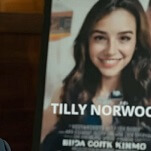Chris Onstad's online comic Achewood frequently spends weeks and even months on wildly disjointed storylines, but few have captured fans' imaginations as strongly as "The Great Outdoor Fight," in which the comics' two lead cats, Ray and Roast Beef, set out to conquer a legendary underground brawl. (Its slogan: "3 Days, 3 Acres, 3,000 Men.") The collected The Great Outdoor Fight (Dark Horse) adds some additional fight mythology, plus an appendix and a glossary, but the main event is Onstad's often hilariously inexpressive art and deadpan surrealism, as well as the way he gets readers to care about the meaning and the lore surrounding The Fight just by having his own characters believe in it so strongly. As dark and rude as Achewood can be at times, what makes the strip so enduring is how much effort the characters put into understanding and respecting the rules of hanging out and being a dude. Well, that and dialogue along the lines of "He was like the Thomas Edison of handing a dude his ass…" A-
Writer Jerry Siegel and artist Joe Shuster created Superman, sold the rights for a pittance, then spent years trying to get proper recognition for their work. That fight for recognition is told only in the postscript to Boys Of Steel: The Creators Of Superman (Knopf), a children's-book collaboration between writer Marc Tyler Nobleman and artist Ross MacDonald; it mostly focuses on the origin story of Superman's creators. But their later struggles also provide subtext to the charming book, which shows how much of the creators' hard work and personalities went into the Man Of Steel, and how their creation helped salve and inspire a down-on-its-luck nation… A-
Marvel had great success with Marvel Zombies and its various sequels, so another, sillier alternate universe was probably inevitable. Hence the new four-issue miniseries Marvel Apes, set largely in a land where characters like Spider-Monkey and Iron Mandrill provide the superheroics. It's a single joke stretched thin by no-better-than-they-have-to-be story and art by Karl Kesel and Raymond Bachs, respectively. A back-up feature from Tom Peyer and Barry Kitson retells the history of the Marvel Apes Universe, beginning with the early days, including Old West heroes Two-Gun Chimp and Rawhide Chimp. The easily amused should have at it… C
Nate Powell's ambitious graphic novel Swallow Me Whole (Top Shelf) explores the relationship between two troubled Southern siblings—one with OCD, one with schizophrenia—and how they interact with their classmates, their parents, and their equally disturbed grandmother. Powell's heavy inks and scrawling style makes the book's story harder to follow than it needs to be, but he also achieves some stunning effects with the art and the lettering. (Rarely has a cartoonist conveyed background chatter so convincingly.) Powell has a look halfway between Charles Burns and Craig Thompson, and at times, Swallow Me Whole enters that rarified sphere of art comics where the page design alone achieves the mood and meaning that that the artist is shooting for. Choppy as it is, Swallow Me Whole captures the desperation of the clinically obsessed, and how from the right angle, it can look like genius… B
With his years of experience writing and drawing the complicated sexual dynamics of Strangers In Paradise, Terry Moore seems like a natural choice to take over Runaways (Marvel), the frequently dysfunctional bunch of outlaw super-teens created by Brian K. Vaughan and Adrian Alphona. Moore's first issue working with artist Humberto Ramos isn't the smoothest transition, however, if only because Ramos' action-happy, graffiti-and-animation-influenced art makes for a major shift in gears for the series. Whether the Runaways we've come to know still exist beneath those mile-wide eyes and jutting chins remains to be seen. Maybe future issues will be more encouraging… C+
Seth Green is heavily credited on the various incarnations of the superhero saga Freshmen, but only as "co-creator." The series was written by Hugh Sterbakov and illustrated by various artists, which makes it feel like Green threw a few ideas at the wall and walked away—possibly after an evening of brainstorming and brain-altering substances, given some of Freshmen's contents. The hardback collection of the first story arc, Freshmen: Vol. 1 (Top Cow), is a standard-issue origin story: a super-science machine goes awry and a handful of college freshmen gain superpowers, based on what they were thinking about at the time. This is more useful in some cases than in others: The hapless kid who was measuring his schlong after a humiliating forced exposure at the local frat winds up hugely overendowed and mostly booted from the book, while the dipshit who'd just covered himself with sticky notes for fun winds up with random-detritus-attracting abilities, and the drunk guy gets the power to intoxicate others by belching at them. Only a few of the group gain abilities that actually come in handy when the accident that gave them powers turns out to have deeper ramifications. That's part of the fun—few other superhero books are willing to step outside wish-fulfillment mode—but it also contributes to the overall feel of a random, chaotic mixed bag that wants to be hilarious and satirical, yet thrilling and action-packed at the same time. In trying to be both, it winds up watered down on both counts. The best aspect comes from the superhero-wannabe comics fan who was out getting pizza during the event, and winds up forlornly hanging around his newly empowered friends, trying to lead them. There's a lot of angst and pathos in his story, but even so, it gets redundant. Above-average art and solid coloring boosts the book a good bit, but it's still wobbly throughout. The first book covers a complete story arc, while the single-issue special Freshmen: Summer Vacation Special is a disposable mini-story with the same characters, simpler, flatter art, and some repetitive character re-introductions; even fans eagerly awaiting Freshmen Vol. 2 later this month could easily skip it and not miss much… Freshmen Vol. 1, C+; Vacation Special, C-
Danica Novgorodoff's Slow Storm (First Second) only gradually coheres as a multifaceted story about a lonely female firefighter and the illegal immigrant she tries to shelter; for half its length, it's so muddy and disjointed, visually and narratively, that it feels more like a drunken dream. Novgorodoff's blotchy, watercolor illustrations are so inconsistent and impressionistic that the book often seems like outsider art, and it's hard going at first, but by the end, it's achieved a woozy, sorrowful feel that becomes mesmerizing. Still, more control over the story earlier, and fewer dead-end digressions would have helped the final product considerably… C+
Grant Chastain makes some overly familiar choices in his graphic novel Corrective Measures (Arcana)—the lines taken from Watchmen and The Killing Joke, the formal-voiced Muslim prison leader and hot, conflicted infirmary head reminiscent of characters from Oz. He makes some odd ones, as well—early on, it's explained that the supervillains in the book's maximum-security prison are controlled by collars that nullify their powers, and yet he shows people using those powers, albeit in minor, non-destructive ways. Which leaves the parameters of the situation way up in the air. Still, the book is a solid drama about a little-considered aspect of the superhero world, sort of a parallel Gotham Central where unpowered guards attempt to ride herd over the worst supervillains their world has to offer, and the new head of the violent crimes wing debates how he's going to handle his new position. This initial volume ends with a hint of more to come, but in the meantime, it offers up some interrelated short stories, none more compelling than the one about the aging long-timer who's denied parole and sets out to be the prison's first escapee. By focusing as much on the humanity of his characters as on their monstrosities, Chastain winds up with an impressively textured world… B
Rick Geary finally moves out of the Victorian era with his new series, "A Treasury Of XXth Century Murder." The initial offering? The Lindbergh Child (NBM/ComicsLit), a detailed analysis of one of the most famous crimes of its era. As always, Geary presents the case in a barrage of factoids, which seem to imply a greater meaning than they ultimately reveal. (The answer to the question "Who kidnapped Charles Lindbergh's baby?" isn't as easy to answer as it initially appears.) As for the differences between XXth Century Murder and Victorian Murder, they mainly have to do with the rise of the mass media, and the way impossible mysteries become all the more frustrating when so many people are following the story. Geary's Victorian series was all about the creepy America that was; this new series looks like it'll be about the creepy America that is… A-
Adam Gallardo's last stand-alone book, Gear School, read like a Readers Digest version of every mecha anime ever made: It was functional but perfectly generic. His new 100 Girls, from the Simon & Schuster imprint Simon Pulse, is a huge step forward: a superhero story that feels like it was geared for DC's Minx line, except it's more propulsive and absorbing by far than Minx books have been of late. It starts with one girl, Sylvia, who discovers she has super strength and agility; before long, she learns there are other girls identical to her, each with different powers. When they get together, things get weird. The story feels like it's pitched at teen girls, except that it's intermittently pretty bloody, either for a teen comic or for a girl comic: Sylvia has a tendency to rip off limbs, tear out guts, and pummel people to death when she gets mad, and the story goes in explosive directions. (It'd make a great action movie.) Todd Demong's art is slightly manga-y and significantly cartoony, which just makes the book feel more like an after-hours Cartoon Network series; it's easy to imagine his work in motion. The first volume suggests more to come, but it could stand alone as a solid, grim actioner for those who can live without neat, happy endings… A-
Speaking of Minx books, the latest, Janes In Love (a sequel to The Plain Janes) includes one panel where several of its protagonists enter a scene talking, each with a mononymic word balloon: "Science." "Books." "Art." "Sports." It's meant as a sort of jokey summary of their conversations and their obsessions, but it feels more like a summary of the whole book, where people talk in unnatural ways and often seem to be awkwardly monologuing rather than interacting. (In what world do teenage girls say things like "If I could just create an odor that is pleasing to Melvin, I could ask him to the dance and be assured that he would say yes"? Or for that matter, "I am a magnificent creature, and I do not care to hang out with mere plebes today!") The four teen-girl protagonists, all named Jane, each embody an obsession, but they're so stiff and humorless about it that they turn into flat, silly caricatures, and it's hard to care about their lovelorn angsts. The sole exception is the book's mastermind, who's trying to bring public art to her small town in spite of a resistant, foaming caricature cop who wants to bring her down. Her actual art projects are neat, and there's some depth to her relationship with her traumatized mom, who's paralyzed by fear of what's going on in the world, but little else in Janes In Love resembles art or life… C-
David Hine's collected book Strange Embrace And Other Nightmares (Image) feels more than a little like an old EC comic, with its layered horrors, unfolding stories-within-stories, and narrative gatekeeper: a creepy, mind-reading albino who keeps a basement full of trapped ghosts who tell their stories at his behest. But the heavy-lined, shadow-intensive, baldly simple art doesn't fit the EC mold, and neither do the frankly amoral stories. Most of the book is devoted to a long gothic tale told by the albino, who used his powers to ferret it out of an old hermit's mind, and forces it on a shopkeeper's boy who brings the hermit food. It's a complicated story of sex, madness, betrayal, sickness, and punishment, with some crazed African-idol fetishism thrown in for good measure. The art is frankly, aggressively ugly—think Richard Sala, if he replaced all his soft curves with bladed corners, and his pastel palette with harsh browns, greys, and reds—as if out to assault readers with a style as disturbing as the story. But it's a painfully compelling package, particularly once the book moves past layers of frame story and gets to the fetid meat of the matter. The collected horror stories at the end are just bonus courses after a banquet of creepiness… A-
Fans of the defunct HBO show Carnivale may find a few familiar chords in Phil Hester's new series Golly! (Image), in which a dim-witted, hard-luck carny ("I ain't a carny, I'm a driver.") is tasked with fighting the minions of Satan. Seems the apocalypse has been called off due to general apathy, but Hell still has a bunch of pieces left in play on Earth, and someone has to pick them up. As a multi-dimensional angel explains to protagonist Golly Munhollen, his general stupidity and ineptness isn't really an issue; from heaven's perspective, picking out a smarter human avatar would be like trying to pick out the brightest amoeba from a puddle. The first issue offers a fairly intriguing blend of outré heavenly philosophy and grudgy down-to-earth behind-the-scenes moments at a run-down carnival, and it ends with a bang; it isn't clear where things are headed from here, but it looks like they might be really fun to watch… B+
Image's "Frank Frazetta's" series is a distinct oddity. All Frazetta contributes is the covers, with the comics promising to tell the secret stories behind some of his famous paintings. And yet each of the series' unrelated one-shots also offer multiple non-Frazetta alternate covers, so what's the point, exactly? Concept aside, the execution varies. Frank Frazetta's Dracula Meets The Wolfman is pretty bare-bones: Dracula meets the Wolfman. They fight. A lot. There's a girl involved, but only barely. The single-issue story, written by Steve Niles and illustrated by Francesco Francavilla, feels more like a student-film short than a comic. Far more successful, dense, and fun is Frank Frazetta's Creatures, which pits an ass-kicking Teddy Roosevelt and his magic gem against a resurrected Mayan god and a horde of possessed Martians. Rick Remender's story and Peter Bergting's art both add up to something that feels like a BPRD spin-off, but it's giddy good fun, with cameos from other writers and characters hinting at a League Of Extraordinary Gentlemen homage as well. It's lightweight, but it packs a lot of punch into just a few pages. Dracula: C-; Creatures: B







































